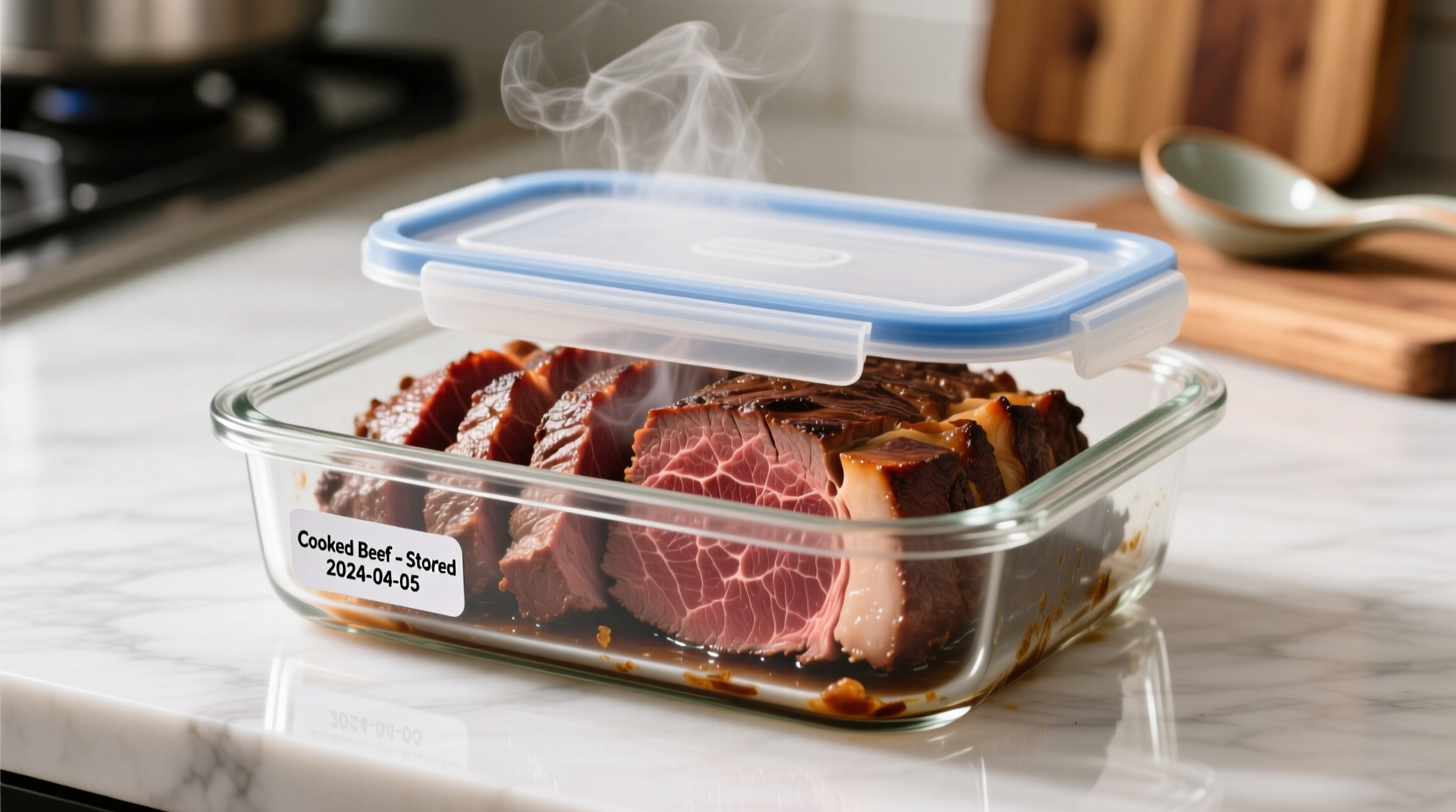Discover exactly how long your cooked beef leftovers stay safe in the refrigerator with science-backed storage guidelines that protect your health. This guide delivers precise timelines, spoilage indicators, and professional storage techniques that home cooks need to prevent food waste and foodborne illness.
The Science Behind Cooked Beef Refrigeration Safety
Understanding why cooked beef has a limited refrigerator lifespan begins with bacterial growth patterns. While cooking destroys harmful pathogens initially present in raw beef, the cooling and storage process creates conditions where bacteria can regrow.
The USDA Food Safety and Inspection Service confirms that cooked beef enters the "danger zone" (40°F-140°F) where bacteria multiply rapidly after the 4-day mark. This critical timeframe isn't arbitrary—it's based on extensive food safety research tracking bacterial proliferation in cooked meats under various storage conditions.
| Storage Time | Bacterial Growth Level | Safety Assessment |
|---|---|---|
| 0-2 days | Minimal | Optimal safety and quality |
| 3 days | Moderate | Safe if properly stored |
| 4 days | Significant | Consume immediately or freeze |
| 5+ days | Dangerous | Discard to prevent illness |
Maximizing Your Cooked Beef's Refrigerator Lifespan
Proper storage techniques significantly impact how long cooked beef remains safe. Follow these evidence-based methods to maximize freshness while maintaining safety:
Cooling Process Matters Most
How you cool cooked beef before refrigeration determines its actual shelf life. The FDA Food Code specifies that cooked foods should cool from 140°F to 70°F within 2 hours, then to 40°F within an additional 4 hours. Divide large portions into shallow containers no deeper than 2 inches to accelerate cooling.
Airtight Containers Prevent Contamination
Transfer cooked beef to airtight containers within 2 hours of cooking. Glass containers with locking lids maintain temperature stability better than plastic alternatives. Leave approximately 1 inch of headspace in containers to accommodate thermal contraction during cooling.
Strategic Refrigerator Placement
Store cooked beef on middle shelves where temperature fluctuations are minimal. Avoid refrigerator doors where frequent opening causes temperature variations. Maintain your refrigerator at exactly 37°F—use a standalone thermometer to verify accuracy, as built-in displays often misread by several degrees.

Recognizing Spoilage: Beyond the 4-Day Mark
While the 3-4 day guideline provides a safety buffer, visual indicators offer additional protection against foodborne illness. The USDA provides specific spoilage markers for cooked beef that override calendar-based decisions:
- Color changes: Grayish-brown discoloration throughout (not just surface browning)
- Texture issues: Slimy film or sticky surface that persists after rinsing
- Odor warnings: Sour, ammonia-like, or unpleasant odors (fresh cooked beef has mild roasted aroma)
- Mold presence: Any visible mold growth means immediate discarding
When in doubt, throw it out—food poisoning from spoiled cooked beef can cause severe gastrointestinal illness. The CDC reports that Staphylococcus aureus and Clostridium perfringens commonly proliferate in improperly stored cooked meats, causing symptoms within hours of consumption.
Special Considerations for Different Beef Preparations
Certain cooking methods and ingredients affect refrigerator longevity:
- Ground beef: Consume within 2 days due to increased surface area for bacterial growth
- Beef in gravy/sauce: The 3-4 day rule still applies, but acidic components like tomatoes may extend safety margin slightly
- Marinated beef: Acidic marinades don't significantly extend refrigerator life—follow standard guidelines
- Leftover roast: Large cuts maintain safety longer than shredded or diced portions
When Freezing Becomes Your Best Option
If you won't consume cooked beef within 3-4 days, freezing preserves safety indefinitely (though quality declines after 2-3 months). For optimal results:
- Vacuum-seal portions before freezing
- Label with contents and freezing date
- Thaw overnight in refrigerator—never at room temperature
- Reheat to 165°F internal temperature before serving
Avoiding Common Refrigeration Mistakes
These frequent errors shorten cooked beef's safe storage period:
- Leaving cooked beef at room temperature longer than 2 hours (1 hour if ambient temperature exceeds 90°F)
- Storing in non-airtight containers that allow moisture loss and cross-contamination
- Placing hot food directly in refrigerator, raising internal temperature
- Using the same cutting board for raw and cooked beef without proper sanitizing
Frequently Asked Questions
Can I eat cooked beef after 5 days in the refrigerator?
No, cooked beef should not be consumed after 5 days in the refrigerator. The USDA Food Safety and Inspection Service strictly recommends discarding cooked beef after the 4-day maximum to prevent foodborne illness, regardless of appearance or smell.
Does reheating cooked beef extend its refrigerator life?
No, reheating does not reset the 3-4 day safety clock. Each reheating cycle actually accelerates quality degradation and provides additional opportunities for bacterial growth during cooling periods. Reheat only the portion you plan to eat immediately.
How can I tell if cooked beef has gone bad before the 4-day mark?
Check for visible spoilage signs including grayish discoloration throughout (not surface browning), slimy texture that persists after rinsing, sour or ammonia-like odors, or any mold growth. If present, discard immediately regardless of storage duration.
Does the cooking method affect how long cooked beef stays fresh?
Yes, cooking method impacts refrigerator longevity. Ground beef should be consumed within 2 days due to increased surface area, while large roasts maintain safety closer to the full 4 days. Acidic components like tomatoes in sauces may slightly extend safety margins, but the 3-4 day guideline remains the standard recommendation.











 浙公网安备
33010002000092号
浙公网安备
33010002000092号 浙B2-20120091-4
浙B2-20120091-4